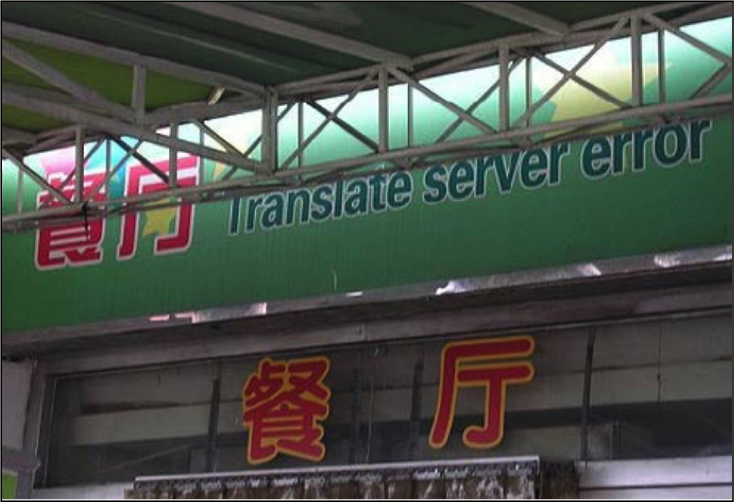
What is Machine Translation?
Machine Translation (MT) is the process by which computer software is used to translate text from one language to another (e.g. French into English). There are three general types of MT, each with their own set of strengths and weaknesses, covered in further detail at the end of this article ([1]) ([2]).
How Should MT Be Used?
In the current state of the technology, machine translation still requires professional translators to work with the content to ensure that the translation is accurate to the source, idiomatic in the target language, and culturally appropriate for the target market. For non translators, MT serves best as a means to get a general idea of the message being conveyed, but should not be used for important professional communications, nor to produce content distributed outside the organization for the reasons outlined in the following section (1)(2)([3])([4])([5]).
Common Pitfalls of Using MT Without Translator Editing:
- Words can have multiple meanings in either language based on context. A professional translator with experience in the industry is needed to make sure the source word was translated correctly in context.
- Example: The term “bladder” in English is defined as follows([6]):

Not all languages use the same term for both of these definitions. For example, in Russian the term for an anatomical bladder (definition 1) is “мочевой пузырь”, whereas a bladder for a pump machine (definition 2) would be “Диафрагма”. The target reader would likely be very confused if the incorrect term was used in Russian. In addition, when faced with homographs, words that are spelled the same but have very different meanings, it is very important that the professional translator verify the correct meaning of the source word in order to determine the appropriate translation. The table below lists a few common examples.
| Term | Meaning 1 | Meaning 2 | Meaning 3 | Meaning 4 |
| bow | front of a boat | bend forward at the waist | knot tied with a ribbon | item that shoots arrows |
| fair | reasonable | festival | nice appearance | |
| bank | piece of land next to river | place where money is deposited | ||
| tear | rip | liquid from the eye |
- MT may not recognize idioms and translate phrases literally instead of conveying the intended meaning. Without the oversight of a qualified translator to review the content, a phrase may be mistranslated and confuse the target reader.
- Example: In French “Se faire la belle” means “to run away”, but is literally translated as “Make beautiful” in MT ([7]).

- If MT does not recognize a word or acronym, the word may be completely omitted from the translation, left untranslated, or an error message may be produced.
- Example: The Chinese characters below mean “Restaurant”. When typed into MT, there was an error message produced in English “Translate server error” that was assumed to be the correct translation, likely because the user was not proficient in both languages ([8]).

- Translation content found on free online MT resources can be modified by anybody with access to the internet—and these individuals may or may not speak either language well. This means that there is no guarantee that content is accurate. In addition, any text typed into these free resources becomes part of the public domain, which may be problematic for industries with strict confidentiality regulations.
- For the reasons listed above, using MT as the primary source of translation may actually not save any time or money for companies since there may be a high level of post-MT editing required. It can also be frustrating for professional translators to clean up poor word and grammar choices, leading to lengthier timelines and strained partnerships.
The 3 Types of MT
- Rules-based MT: First form of MT, developed in the 1950s. Combines language dictionaries and grammar rules to produce translations.
- Pros: More consistent when translating within a specific context.
- Cons: Produces literal, word-for-word translations that may not sound natural in the target language.
- Statistical MT: Instead of utilizing language rules, the MT analyzes large amounts of data (e.g. words, sentence fragments, phrases) to determine frequency of use and the probability that a target language data set will align with a particular source language data set.
- Pros: Has a more fluent sound since it has a wider range of weighted options. Quality of translations can be improved by feeding in more correct examples of translated content.
- Cons: Is less consistent since there are more word and phrase options available. The potential to produce poor translations increases significantly when incorrect translations are not caught and corrected since increasing the frequency of use will mistakenly weight the incorrect translations as a good match, therefore increasing the likelihood that it will be used more and more in similar phrases.
- Neural Machine Translation (NMT): Modeled after the human brain, an artificial neural network is trained to perform even more complex probability calculations than statistical MT by utilizing vector representations of content.
- Pros: Quality, consistency, and fluency potential increase significantly and surpass that of statistical MT when the NMT is trained extensively in a particular context (e.g. a certain industry, discipline, or genre) by a qualified professional translator with experience in the context field.
- Cons: Can be unpredictable when not well-trained or encountering new content, producing incorrect and/or incomplete translations. Requires extensive time and millions of translation units to train the MT to produce high quality translations.
Summary
Machine translation has come a long way since it was pioneered in the 1950s with the rules-based approach. Since then, statistical and neural MT approaches have improved the quality of vocabulary, grammar, and natural-sounding translations produced. At this point in time, there is still considerable development that needs to take place before machines can translate both efficiently and accurately without heavy editing. Therefore, we recommend that non translators use MT for informal situations only and send important content to qualified professional translators.
Written by Rachel Messenger, Translation Specialist at CPG Documentation, LLC www.cpgcanhelp.com
[1] What is a Machine Translation? SDL Trados https://www.sdltrados.com/solutions/machine-translation/
[2] An Introduction to Neural Machine Translation, Carola F. Berger https://cfbtranslations.com/wp-content/uploads/2018/10/NMTsmall-1.pdf
[3] What is machine translation? American Translators Association https://www.atanet.org/clients/what_is_machine_translation.php
[4] Automation Doesn’t Solve Everything: Six Things You Should Know About Machine Translation, ATA Compass https://theatacompass.org/2016/06/06/automation-doesnt-solve-everything-six-things-you-should-know-about-machine-translation/
[5] MT for Translators, Association for Machine Translation in the Americas https://amtaweb.org/mt-for-translators/
[6] Merriam-Webster https://www.merriam-webster.com/dictionary/bladder
[7] Funny Machine Translation Errors, Star Translation https://www.star-ts.com/languages/funny-machine-translation-errors/
[8] The impact of translation technologies on the process and product of translation, Stephen Doherty https://www.researchgate.net/publication/284725157_The_impact_of_translation_technologies_on_the_process_and_product_of_translation
Back To News
 800-541-8270
800-541-8270